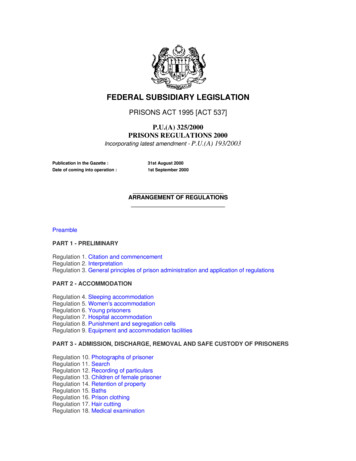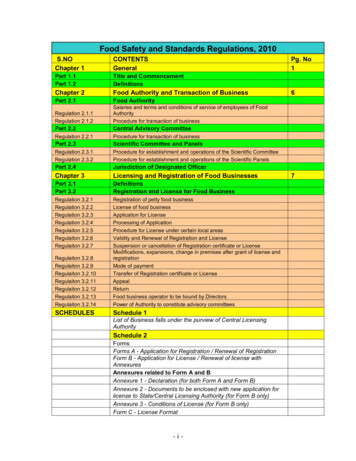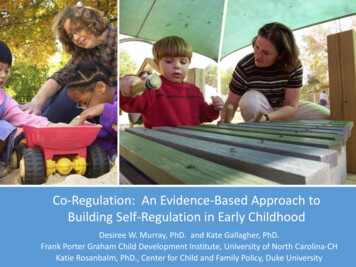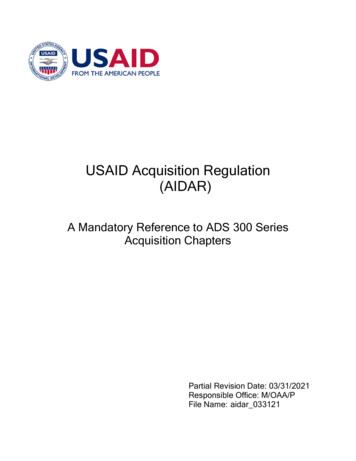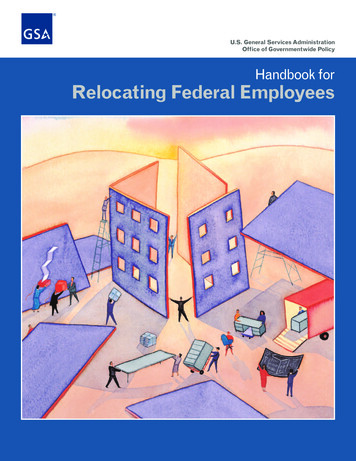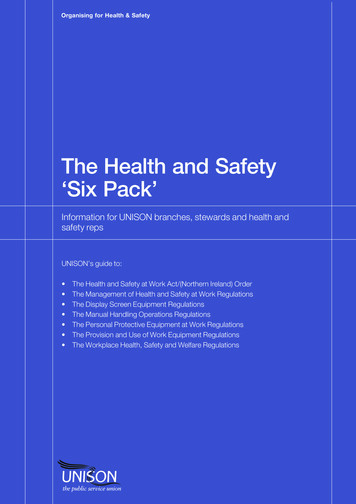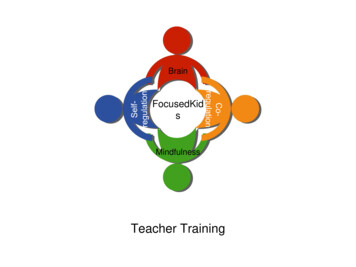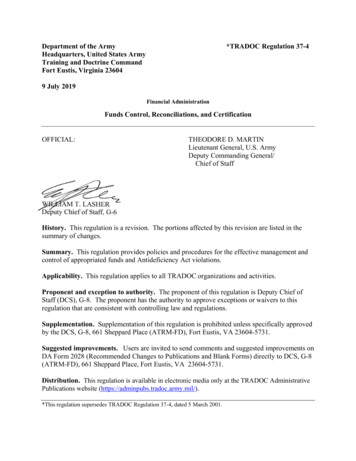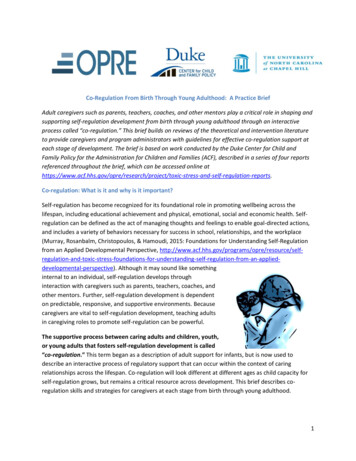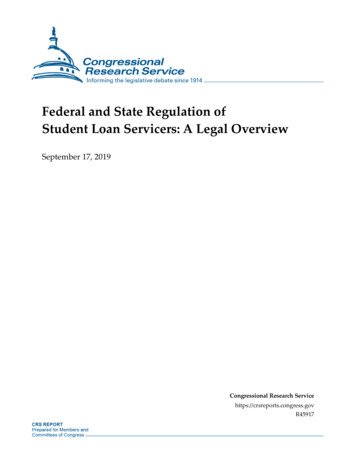
Transcription
Federal and State Regulation ofStudent Loan Servicers: A Legal OverviewSeptember 17, 2019Congressional Research Servicehttps://crsreports.congress.govR45917
SUMMARYFederal and State Regulation ofStudent Loan Servicers: A Legal OverviewAs the federal government’s role in the student loan industry has expanded over time, the UnitedStates has contracted with student loan servicers to help it administer its growing student loanportfolio. These servicers perform a variety of functions, including (1) communicating withborrowers regarding repayment; (2) disclosing information about student loan terms toborrowers; (3) applying payments to outstanding loan balances; (4) processing applications forenrollment in repayment plans; and (5) processing requests for loan forbearance and deferment.Several federal statutes and regulations—along with an array of contractual provisions—mayaffect how these servicers conduct these various functions on the government’s behalf withrespect to federal student loans.R45917September 17, 2019Kevin M. LewisLegislative AttorneyNicole VanatkoLegislative AttorneySome allege that the existing scheme of federal regulation has not deterred servicers from engaging in various forms ofalleged misconduct. According to critics, servicers of federal student loans have engaged in several undesirable behaviors,such as (1) steering borrowers experiencing financial hardship toward forbearance instead of repayment plans that would bemore beneficial; (2) neglecting to inform borrowers of the consequences of failing to promptly submit certain requiredinformation; (3) misinforming borrowers on their eligibility for loan forgiveness; and (4) misallocating or misapplying loanpayments. The servicers deny these allegations.Federal laws governing higher education do not authorize borrowers who have allegedly been harmed by servicer misconductto directly pursue litigation against servicers. Instead, existing law places the primary burden of policing federal student loanservicers upon the federal government. Some commentators disagree, however, over whether the U.S. Department ofEducation (ED) has exercised sufficient oversight over the servicers with which it contracts. Observers have also disagreedover the extent to which other federal agencies, such as the Consumer Financial Protection Bureau (CFPB), shouldparticipate in the regulation of federal student loan servicers.At the same time, more and more states have enacted legislation specifically targeted at student loan servicers. While thespecifics of these laws vary from state to state, many purport to impose legal requirements upon servicers of federal studentloans that go beyond those imposed by federal law, such as supervision by a state ombudsperson or mandatory licensing.Furthermore, in addition to new laws specifically aimed at servicers, state attorneys general and borrowers alike have invokedexisting state consumer protection statutes and common law causes of action against servicers in civil litigation. Theseburgeoning disputes between servicers on the one hand and states and borrowers on the other have raised legal questionsregarding how existing federal law interacts with the growing body of state servicing regulations. ED has taken the positionthat federal law “preempts”—that is, displaces—state laws purporting to regulate servicers of federal student loans. Whilesome courts have agreed with ED’s conclusions on preemption, the bulk of courts have reached the opposite conclusion thatstates retain a role in regulating student loan servicing.This ongoing legal debate has significant legal consequences. On the one hand, if federal law preempts state servicingregulations, servicers will be subject to a single uniform national standard and will not need to expend resources to complywith each jurisdiction’s state-specific regulatory regime. On the other hand, allowing states to enact and enforce their ownservicing laws could fill regulatory gaps where—at least in the view of some critics—existing federal regulation has notensured that servicers perform their duties with sufficient regard for borrowers’ interests. Preserving a regulatory role for thestates could also enable each state to experiment with novel regulatory schemes. Given these legal consequences, severalMembers and committees of the 116th Congress have expressed interest both in the federal regulation of servicers generallyand the preemptive scope of that regulation.Congressional Research Service
Federal and State Regulation of Student Loan Servicers: A Legal OverviewContentsBackground on the Federal Student Loan Programs . 3Federal Laws and Contractual Requirements Governing Student Loan Servicers . 5Statutory Provisions . 5Regulations. 7Regulations Specifically Governing Loan Servicing . 7General Regulatory Duties That ED Has Delegated to Servicers . 9Servicer Contracts with the Federal Government . 9Role of the Consumer Financial Protection Bureau . 10Allegations of Servicer Misconduct .11Forbearance Steering .11Income Recertification . 13Loan Forgiveness Eligibility . 13State Laws Regulating Servicers of Federal Student Loans . 14State Laws Governing Student Loan Servicers Specifically . 14State Laws of General Applicability . 18Preemption and the Interaction of Federal and State Servicing Laws. 19Federal Preemption . 19ED’s Interpretation. 20Recent Litigation. 21Considerations for Congress. 27ContactsAuthor Information. 30Congressional Research Service
Federal and State Regulation of Student Loan Servicers: A Legal OverviewThe United States has created vast federal loan programs offering to millions of studentsalternatives to private educational loans.1 According to the U.S. Department ofEducation’s (ED’s) Office of Federal Student Aid (FSA), nearly 43 million borrowersowed money on federal student loans as of the second quarter of 2019, and the totalamount of outstanding federal student loan debt currently exceeds 1.4 trillion—afigure that has nearly tripled since 2007.2 In recent years, a significant number of these borrowershave experienced difficulty repaying their student loans.3 Moreover, borrowers who lack financialexperience may need guidance to navigate the student loan repayment process, which someborrowers find daunting or confusing.4 Student loan servicers5—with whom the United States hascontracted to assist with the administration of its sizable student loan portfolio6—are a key sourceof guidance and assistance for borrowers struggling to understand and repay their federal studentloans.7 Under its contract with the federal government, a servicer may be responsible for (amongother things)1See, e.g., Daniel A. Austin, The Indentured Generation: Bankruptcy and Student Loan Debt, 53 SANTA CLARA L.REV. 329, 338-39 (2013) (tracing the development of federal student loan programs from 1958 to the present).Other CRS products discuss the various federal student loan programs in greater detail. See CRS Report R43351, TheHigher Education Act (HEA): A Primer, by Alexandra Hegji, at 13-14, 15-17 [hereinafter Hegji, Primer]; CRS ReportRL31618, Campus-Based Student Financial Aid Programs Under the Higher Education Act, by Joselynn H. Fountain;at 10-16; CRS Report R40122, Federal Student Loans Made Under the Federal Family Education Loan Program andthe William D. Ford Federal Direct Loan Program: Terms and Conditions for Borrowers, by David P. Smole, at 1-4.A different legal framework governs private student loans, so this report does not focus on them. Private loans, as thename implies, are neither issued nor guaranteed by the federal government. E.g., Jonathan D. Glater, Student Debt andthe Siren Song of Systemic Risk, 53 HARV. J. ON LEGIS. 99, 110 n.54 (2016). Congress has opted to regulate privatestudent loans differently from federal student loans in various respects. Compare, e.g., 15 U.S.C. § 1638(e) (providingthat the Truth in Lending Act (TILA) applies to “private education loans” but does not apply to most federal loans),with, e.g., id. § 1603(7) (providing that federal “[l]oans made, insured, or guaranteed pursuant to a program authorizedby Title IV of the Higher Education Act of 1965” are not subject to TILA’s requirements relating to consumer creditcost disclosure).2 Fed. Student Aid, Federal Student Loan Portfolio, U.S. DEP’T OF EDUC., ent/portfolio (last visited September 6, 2019).3 See, e.g., Nat’l Ctr. for Educ. Statistics, Stats in Brief: The Debt Burden of Bachelor’s Degree Recipients, U.S. DEP’TOF EDUC. 16 (2017), https://nces.ed.gov/pubs2017/2017436.pdf (reporting that many student loan borrowers face a debtburden that exceeds “a manageable percentage of income that a borrower can be expected to devote to loanrepayment”).4 See, e.g., CONSUMER FINANCIAL PROTECTION BUREAU, STUDENT LOAN SERVICING: ANALYSIS OF PUBLIC INPUT ANDRECOMMENDATIONS FOR REFORM 18, 20 (2015), https://files.consumerfinance.gov/f/201509 cfpb student-loanservicing-report.pdf (“[The various federal student loan programs] feature a range of different borrower benefits andprotections that can affect borrower performance, payment amount, interest rate, and other key loan terms and features. . . . [B]orrowers experiencing financial hardship may not be able to understand and enroll in appropriate programswithout assistance from their student loan servicer.”); Amanda Harmon Cooley, Promissory Education: Reforming theFederal Student Loan Counseling Process to Promote Informed Access and to Reduce Student Debt Burdens, 46 CONN.L. REV. 119, 143 (2013) (describing “the loan repayment process” as “complex for student borrowers, most of whomhave relatively little financial experience or savvy”).5 This report addresses only federal student loan servicers; it does not discuss collectors of student loans. Loancollection implicates slightly different legal issues. See, e.g., Brannan v. United Student Aid Funds, Inc., 94 F.3d 1260,1261-66 (9th Cir. 1996) (analyzing whether federal law preempted state law claims relating to collection of federalstudent loan); Linsley v. FMS Inv. Corp., No. 3:11cv961 (VLB), 2012 WL 1309840, at *1-8 (D. Conn. Apr. 17, 2012)(same).6 See, e.g., USA Grp. Loan Servs., Inc. v. Riley, 82 F.3d 708, 711 (7th Cir. 1996) (“[T]he student loan program placesheavy administrative burdens on the entities involved in it . . . A whole industry of ‘servicers’ has arisen to relieve theseentities of some of the administrative burdens.”).7 See, e.g., Student Loan Servicing All. v. Dist. of Columbia, 351 F. Supp. 3d 26, 39 (D.D.C. 2018); CRS ReportR44845, Administration of the William D. Ford Federal Direct Loan Program, by Alexandra Hegji, at 19-22Congressional Research Service1
Federal and State Regulation of Student Loan Servicers: A Legal Overview communicating with borrowers regarding repayment;disclosing information about student loan terms to borrowers;applying payments to outstanding loan balances;processing applications for enrollment in repayment plans;processing applications for loan forgiveness or discharge; andprocessing requests for loan forbearance or deferment.8Some maintain that at least some of these federal student loan servicers have engaged in variousforms of undesirable conduct,9 such as steering borrowers away from beneficial repaymentoptions10 or providing inaccurate11 or incomplete12 information. Representatives from theservicing industry deny these accusations.13These allegations of servicer misconduct have drawn the attention of both federal and statepolicymakers. At least two congressional subcommittees have conducted hearings on student loanservicing within the past few months,14 and the House Committee on Financial Services[hereinafter Hegji, Administration]; U.S. DEP’T OF EDUC. OFFICE OF INSPECTOR GENERAL, FEDERAL STUDENT AID:ADDITIONAL ACTIONS NEEDED TO MITIGATE THE RISK OF SERVICER NONCOMPLIANCE WITH REQUIREMENTS FORSERVICING FEDERALLY HELD STUDENT LOANS 5-6 (Feb. 12, 2019) [hereinafter OIG REPORT]. See generally infra“Servicer Contracts with the Federal Government.”8 See Hegji, Administration, supra note 7, at 20. See also, e.g., OIG REPORT, supra note 7, at 5-6 (stating that ED hashired servicers to “collect[] payments on federally held student loans that are not in a default status, advis[e] borrowerson available resources to better manage their loan obligations, respond[] to borrowers’ inquiries, and perform[] otheradministrative tasks associated with collecting and servicing federally held student loans on behalf of [ED]”). Thegovernment has contracted with slightly over a dozen servicers at various times over the past decade, although severalof those entities no longer service federal student loans. See, e.g., OIG REPORT, supra note 7, at 5-6 & n.7 (listing anddescribing the entities with which ED has contracted to service federal student loans). Portions of these contracts arepublicly available at iness-info/contracts/loan-servicing.9 See infra “Allegations of Servicer Misconduct.” Notably, allegations of servicer misconduct have captured theattention of the ED Office of Inspector General (OIG), which published an audit report in early 2019 that identifiedinstances of servicer “noncompliance with requirements relevant to forbearances, deferments, income-drivenrepayment, interest rates, due diligence, and consumer protection.” OIG REPORT, supra note 7, at 4. OIG ultimatelyconcluded that ED’s Office of Federal Student Aid (FSA)—the primary ED office responsible for administering theloan programs—had “rarely h[eld] servicers accountable for instances of noncompliance with Federal loan servicingrequirements.” Id. at 17. Although FSA disputed the OIG report’s factual findings, see id. at 42, it agreed with thereport’s recommendations for improving servicer oversight and claimed it has already implemented (or is in the processof implementing) many of those recommendations. Id. at 46-47 (Feb. 12, 2019) (FSA response to OIG report). See alsoid. at 42 (describing “significant ongoing improvements [FSA] has made to [its] oversight and monitoring policies andprocedures, some of which directly align with the recommendations included in [OIG’s] report”).10 See infra “Forbearance Steering.”11 See infra “Loan Forgiveness Eligibility.”12 See infra “Income Recertification.”13 See, e.g., An Examination of State Efforts to Oversee the 1.5 Trillion Student Loan Servicing Market: HearingBefore the Subcomm. on Oversight & Investigations of the H. Comm. on Fin. Servs., 116th Cong. ripts-5565345?8 [hereinafter 6/11/19 Hr’g] (testimony of Scott Buchanan,Executive Director, Student Loan Servicing Alliance) (“I’m unaware of any servicer who provides compensation to putsomeone into forbearance.”).14 As of September 15, 2019, neither of the official transcripts of these hearings are available. The reader may accessunofficial transcripts at Protecting Student Borrowers: Loan Servicing Oversight: Hearing Before the Subcomm. on theDep’ts of Labor, Health & Human Servs., Educ., and Related Agencies of the H. Comm. on Appropriations, 116thCong. (2019), 481087?3 [hereinafter 3/6/19 Hr’g]; 6/11/19 Hr’g,supra note 13. This report cites to these unofficial transcripts herein.Congressional Research Service2
Federal and State Regulation of Student Loan Servicers: A Legal Overviewconducted another hearing on the topic on September 10, 2019.15 Additionally, several statelegislatures have enacted new laws to regulate student loan servicers within the past few years.16A number of state attorneys general and individual borrowers have also tried to pursue civillitigation against servicers of federal student loans based on alleged violations of state statutoryand common law.17The states’ involvement has raised questions involving the appropriate interaction betweenfederal and state law, as well as the respective roles of the federal and state governments withrespect to regulating student loan servicers. Significantly, ED has taken the position that theexisting regime of federal regulation of student loan servicers leaves no room for state regulationon the topic.18 While some courts have agreed with this position, others have concluded thatcurrent federal law permits the state to regulate servicers with whom the federal governmentcontracts.19This report analyzes the regulation of servicers of federal student loans. After providing necessarybackground information regarding the federal student loan programs,20 the report describesfederal law governing student loan servicers.21 The report then discusses how some states andborrowers have tried to enact or enforce state laws to regulate servicers of federal student loans.22Then, the report analyzes the legal issues implicated by the interaction of federal and stateservicing laws, including whether (and, if so, to what extent) federal servicing regulationpreempts the states from creating or enforcing servicing laws of their own.23 The report concludesby identifying relevant legal considerations for Congress.24Background on the Federal Student Loan ProgramsThe federal government’s roles with respect to the operation, supervision, and administration offederal student loan programs have evolved over time.25 Around the turn of the millennium, forinstance, most (though not all) federal student loans were issued under the now-discontinued15This hearing was entitled A 1.5 Trillion Crisis: Protecting Student Borrowers and Holding Student Loan ServicersAccountable. The Committee’s web page for the hearing is available at single.aspx?EventID 404230.16 See infra “State Laws Governing Student Loan Servicers Specifically.” Connecticut enacted one of the first suchstatutes in 2015. See An Act Concerning a Student Loan Bill of Rights, 2015 Conn. Legis. Serv. P.A. 15-162 (H.B.6915) (2015).17 See infra “State Laws of General Applicability.”18 See Federal Preemption and State Regulation of the Department of Education’s Federal Student Loan Programs andFederal Student Loan Servicers, 83 Fed. Reg. 10,619, 10,619 (Mar. 12, 2018) [hereinafter ED Interpretation] (assertingthat “the servicing of Direct Loans is an area ‘involving uniquely Federal interests’ that must be ‘governed exclusivelyby Federal law’”) (quoting Boyle v. United Techs. Corp., 487 U.S. 500, 504 (1988)).19 See infra “Preemption and the Interaction of Federal and State Servicing Laws.”20 See infra “Background on the Federal Student Loan Programs.”21 See infra “Federal Laws and Contractual Requirements Governing Student Loan Servicers.”22 See infra “State Laws Regulating Servicers of Federal Student Loans.”23 See infra “Preemption and the Interaction of Federal and State Servicing Laws.”24 See infra “Considerations for Congress.”25 See, e.g., Wenhua Di & Kelly D. Edmiston, State Variation of Student Loan Debt and Performance, 48 SUFFOLK U.L. REV. 661, 664 (2015) (“The student loan market has undergone substantial reform since the last recession, such thatthe federal government’s role and programs have changed. For instance, the [FFELP], which provided guarantees(insurance) and, in many cases, borrower subsidies, for qualified privately-issued student loans, was replaced by the[FDLP], under which the federal government provides student loans directly to borrowers.”).Congressional Research Service3
Federal and State Regulation of Student Loan Servicers: A Legal OverviewFederal Family Education Loan Program (FFELP),26 under which private lenders extended loansto borrowers that the federal government guaranteed against the risk of loss.27 Although thefederal government set the terms and conditions of FFELP loans28 and subsidized the FFELPprogram,29 various entities other than the federal government also helped operate the FFELP.30For example, private lenders (or third parties with which those lenders contracted) bore theresponsibility of servicing FFELP loans.31Several recent developments, however, have shifted the federal government’s role in the studentloan system.32 In 2008, for instance, Congress enacted the Ensuring Continued Access to StudentLoan Act (ECASLA), which authorized ED to purchase outstanding FFELP loans from privatelenders.33 Thus, for the nearly 4 million loans that ED purchased from private lenders underECASLA, “the federal government is now the ‘lender.’”34 Then, in 2010, Congress enacted theStudent Aid and Fiscal Responsibility Act (SAFRA), which, among other things, terminated theauthority to make new FFELP loans.35 As a result of SAFRA, the United States now issues mostSee Hegji, Primer, supra note 1, at 13 (“For many years the [FFELP] was the primary source of federal student loans. . . .”); Note, Ending Student Loan Exceptionalism: The Case for Risk-Based Pricing and Dischargeability, 126 HARV.L. REV. 587, 591 (2012) (“[FFELP] loans accounted for the majority of federally supported loans each year from 2000to 2010.”).27 E.g., Salazar v. King, 822 F.3d 61, 65 (2d Cir. 2016) (“Under the [FFELP], private lenders issue subsidized studentloans, which are then insured by guaranty agencies (a state or private non-profit organization), which, in turn, areinsured by [ED].”) (citing 20 U.S.C. § 1078(b)-(c); 34 C.F.R. § 682.200); Jamie P. Hopkins & Katherine A. Pustizzi, ABlast from the Past: Are the Robo-Signing Issues that Plagued the Mortgage Crisis Set to Engulf the Student LoanIndustry?, 45 U. TOL. L. REV. 239, 254 (2014) (“Under the [FFELP], private lenders such as Sallie Mae, working undercontract with the federal government, provided ‘loan capital’ directly to the borrower, which the federal governmentguaranteed against loss in the event the borrower defaulted. The loan itself originated with the private lender . . . .”).28 See, e.g., Chae v. SLM Corp., 593 F.3d 936, 944 (9th Cir. 2010) (“The statutes [governing the FFELP] defin[e] therequired terms of each type of loan. The statutes go so far as to mandate specified repayment terms and specifiedinsurance and guaranty requirements. As one example, the FFELP sets the maximum interest rate that a lender maycharge . . . .”) (citing 20 U.S.C. §§ 1074, 1077a, 1078, 1078-2, 1078-3).29 E.g., Michael C. Macchiarola & Arun Abraham, Options for Student Borrowers: A Derivatives-Based Proposal toProtect Students and Control Debt-Fueled Inflation in the Higher Education Market, 20 CORNELL J.L. & PUB. POL’Y67, 98 (2010).30 See, e.g., Bradley J.B. Toben & Carolyn P. Osolinik, Nonprofit Student Lenders and Risk Retention: How the DoddFrank Act Threatens Students’ Access to Higher Education and the Viability of Nonprofit Student Lenders, 64 BAYLORL. REV. 158, 179 (2012) (describing the FFELP as “a public-private partnership”); id. (explaining that along withinsuring private lenders, the federal government also “delegated to ‘state and nonprofit guaranty agencies’ the task ofadministering that insurance”).31 See, e.g., Chae, 593 F.3d 936, 939 (9th Cir. 2010) (“The lenders must abide by the terms of the FFELP, and [ED]may terminate the participation of any lender who does not follow the rules. Lenders may assign their loans to thirdparty loan servicers, in which case the loan servicer must also abide by the FFELP regulations.”) (internal citationsomitted).32 See, e.g., John R. Brooks, The Case for More Debt: Expanding College Affordability by Expanding Income-DrivenRepayment, 2018 UTAH L. REV. 847, 851 (stating that “[a]s a result” of repealing “the federal subsidy for and guaranteeof student loans from private lenders under the” FFELP, “the federal government’s share of all student lending wentfrom 75 percent in 2007-2008 to 93 percent in 2009-2010”); Michael Simkovic, Risk-Based Student Loans, 70 WASH.& LEE L. REV. 527, 588 (2013) (“[T]he U.S. government’s role in the higher education market is primarily as a lender. . . .”).33 Pub. L. No. 110-227, 122 Stat. 740 (2008) (codified at 20 U.S.C. §§ 1070a-1, 1071, 1078, 1078-2, 1078-8, 1087a,1087f, 1087i-1). See also Student Loan Servicing All. v. Dist. of Columbia, 351 F. Supp. 3d 26, 38 (D.D.C. 2018).34 Student Loan Servicing All., 351 F. Supp. 3d at 38.35 Health Care and Education Reconciliation Act of 2010, Pub. L. No. 111-152, §§ 2001-2303, 124 Stat. 1029 (codifiedin relevant part at 20 U.S.C. § 1071(d)). However, some older loans issued under the FFELP remain outstanding. SeeHegji, Primer, supra note 1, at 14 (“Although the authority to make new [FFELP] loans was terminated, borrowers of[FFELP] loans remain responsible for making payments on their loans, loan holders continue to be responsible for26Congressional Research Service4
Federal and State Regulation of Student Loan Servicers: A Legal Overviewnew federal student loans through the Federal Direct Loan Program (FDLP),36 under which thegovernment itself—rather than a private lender—extends loans directly to students.37 Thesedevelopments have thereby expanded the federal government’s direct involvement in the studentloan industry,38 which in turn has prompted the United States to rely increasingly on servicers toadminister aspects of the federal student loan programs.39Federal Laws and Contractual RequirementsGoverning Student Loan ServicersA variety of federal statutes and regulations—as well as contractual provisions—bear on theservicing of federal student loans.Statutory ProvisionsOne such statute is Title IV of the Higher Education Act of 1965 (HEA),40 which (among otherthings) establishes programs to provide financial assistance to postsecondary students,41 includingthe FDLP.42 Title IV also governs loans issued under the now-discontinued FFELP that remainoutstanding.43Title IV contains several provisions that pertain to student loan servicing. The first such provisionis 20 U.S.C. § 1082, which applies to FFELP loans.44 20 U.S.C. § 1082(a)(1), for instance,empowers the Secretary of Education (Secretary) to “prescribe . . . regulations applicable to thirdparty servicers,” “including regulations concerning financial responsibility standards for, and theassessment of liabilities for program violations against, such servicers.”45 Section 1082(a)(1)servicing the loans, and guaranty agencies continue to administer the federal loan insurance program. Approximately 305.8 billion in outstanding [FFELP] loans are due to be repaid in the coming years.”).36 See, e.g., Okla. Firefighters Pension & Ret. Sys. v. Student Loan Corp., 951 F. Supp. 2d 479, 484 (S.D.N.Y. 2013)(noting that SAFRA “eliminated the [FFELP] and brought all federal student lending under the [FDLP]”).37 E.g., Corletta v. Tex. Higher Educ. Coordinating Bd., 531 B.R. 647, 652 n.1 (W.D. Tex. 2015) (explaining that underthe FDLP “loans themselves are issued by the federal government”); Toben & Osolinik, supra note 30, at 181 (statingthat under the FDLP, “funding for all new loans comes directly from the U.S. Treasury”).38 See, e.g., John R. Brooks, Income-Driven Repayment and the Public Financing of Higher Education, 104 GEO. L.J.229, 230 (2016) (“In 2010, the federal government essentially took over the student loan industry . . . .”).39 See OIG REPORT, supra note 7, at 5. (describing FSA’s efforts to contract with student loan servicers in 2009 andbetween 2011 and 2013). See also USA Grp. Loan Servs., Inc. v. Riley, 82 F.3d 708, 711 (7th Cir. 1996) (“[T]hestudent loan program places heavy administrative burdens on the entities involved in it . . . A whole industry of‘servicers’ has arisen to relieve these entities of some of the administrative burdens.”).40 This report uses the acronym “HEA” generically to refer to the provisions currently codified at Title 20, Chapter 28of the U.S. Code, 20 U.S.C. §§ 1001-1161aa-1, even though some of those provisions were technically added by billsother than the Higher Education Act of 1965.41 See id. §§ 1070-1099d (Title IV of the HEA). See also Student Loan Servicing All. v. Dist. of Columbia, 351 F.Supp. 3d 26, 37 (D.D.C. 2018) (“Congress passed the [HEA] ‘to strengthen the educational resources of our collegesand universities and to provide financial assistance for students in postsecond
at 10-16; CRS Report R40122, Federal Student Loans Made Under the Federal Family Education Loan Program and the William D. Ford Federal Direct Loan Program: Terms and Conditions for Borrowers, by David P. Smole, at 1-4. A different legal framework governs private student loans, so this report does not focus on them. Private loans, as the
